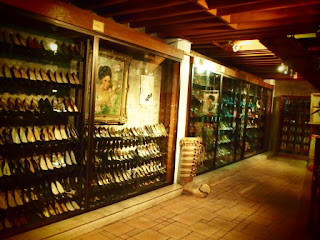 |
| Painting of young Imelda |
The "legacy" of Imelda Marcos’
shoes has always been a fixture of my social introductions in Australia. As soon as new acquaintances learn I'm from the Philippines, they would right away drop Imelda Marcos and her shoe collection. ‘
What happened to her shoes?’ they would curiously ask.
'Well, they are kept in my hometown's shoe museum, as a matter of fact', I would reply, smiling. Shoe talk, not surprisingly, is always a good ice-breaker especially among women. Even after twenty seven years
when the Marcos family fled the Philippines (and eventually returned to politics),
the interest about Imelda and her shoes never wanes.
But every now and then, there is a feeling of discomfort whenever Marikina is associated with Imelda Marcos. After all, I grew up during the Martial Law era, a period where systemic oppression was commonplace especially for those who opposed the Marcos family and their cronies. In the guise of the“New Society” every one
was expected to be a ‘disciplined’ citizen. Government controlled media reinforced
it with repeated reminders of the slogan, ‘For
the country’s progress, discipline is necessary’. It was the time when
television broadcasting stations started and ended the day with what became the
most mocked and satirised song, “Bagong
Lipunan”. It was played over and
over that even after forty years I can still sing the version that my siblings
and I were warned not to perform in front of anyone outside our family. It was
the time when midnight curfew was imposed and when progressive newspapers and
media outlet were shut down. It was the time when thousands of people were
arrested, imprisoned and countless others disappeared or paid the highest sacrifice and lost their lives. Now you know
where all the discomfort is coming from.
 |
| Part of Imelda's 800-pair collection |
Although my hometown is known for
producing quality shoes, tourism has never been a priority until the opening of
the Marikina Footwear Museum in 2001. The
old building that became the museum has always been a landmark in the centre of
Marikina and it is also surrounded by historical buildings. Alongside is the
current cultural centre building and former mansion of Kapitan Moy, a wealthy
businessman who started the shoe industry in Marikina; and across the road is
the old Our Lady of the Abandoned Catholic Church. Nonetheless, the museum that now
housed at least 800 of the 3000 pairs of Imelda Marcos’ shoes had an
interesting claim to history. It was used as an arsenal during the Spanish
period; a detention cell for General Macario Sakay, a resistance leader during
the Filipino-American War; and a rice mill for the Tuason family, one of the
wealthiest landlords in the country.
 |
| Museum entrance |
Bayani Fernando, a wealthy
engineer/developer and the then mayor of Marikina, conceived the idea of the shoe museum
as early as 1998. The project brief was to turn the museum into
“a
significant venue for nurturing the historical and cultural values of the shoe
industry”. Sounds like a very noble
idea for a town known for its shoes. However, as a publicity ploy, the
forward-thinking mayor rode on the coattails of Imelda’s gown and allocated at
least one third of the museum display with Imelda’s shoes. And to complete the publicity
exercise, he invited Imelda to officially open the museum where she was quoted as saying:
“This museum is making a subject of notoriety into an object of beauty.
They went into my closets looking for skeletons, but thank God, all they found
were shoes, beautiful shoes.” As any
journalist would know, Imelda is a bottomless well when it comes to
quotable quotes. She is the complete media ringmaster who always get attention
whether she is doing a rendition of her signature song,
‘Because of you’; kissing the coffin of her frozen husband; or on this
occasion, opening a small town museum.
 |
| Korean tourists excited over Imelda's shoes |
When I visited the museum in
January this year, there was a bus-load of Korean tourists excitedly taking
photos and obviously awed by the collections. The ground floor also contains
shoes from around the world and shoes from other famous people and celebrities.
However, the tourists were not there for reasons other than to see the Imelda
collection. Interestingly enough, I didn’t find any Marikina-branded shoes on display.
A museum poster claims shoemakers from Marikina gave Imelda at least ten pairs
of shoes every week during her time as the First Lady. But where are they? All
I could see were famous foreign brands like Gucci, Pierre Cardin, Christian Dior,
Ferragamo, Chanel and Prada. Are Marikina-made shoes not good enough for Madame
Marcos’ discriminating taste? Was she being duplicitous when she told the media that the 3000 pairs are her way of supporting the local shoe industry? Hopefully, the museum will at least will serve as a shrine to
constantly remind Filipinos of the Marcos' excessive lifestyle and corruption while most of
its people live in abject poverty.
 |
| Not a single Marikina brand in sight |
In 2007, Imelda’s doctor
announced that his patient has to wear orthopaedic shoes because,
“years of wearing ill-fitting shoes has
taken its toll on Mrs Marcos”. Poetic justice? Maybe. The cycle of karma continued last
year when curators of the National Museum in Manila discovered that the
clothing and shoe items of the Marcos’s kept in locked storeroom were destroyed
by water from leaking ceiling during storms. As a consequence, the remainder of Imelda’s shoes were damaged and eaten by termites. In retrospect, these clothing items and shoes may have lost
their material worth, but their real value lies on conveying to Filipinos that
we should not be complacent to the continuous political rise of the Marcos’s
and their cronies. Accidentally, but of great importance nonetheless, we should
never be complacent with termites and leaky roof in our National Museum.











